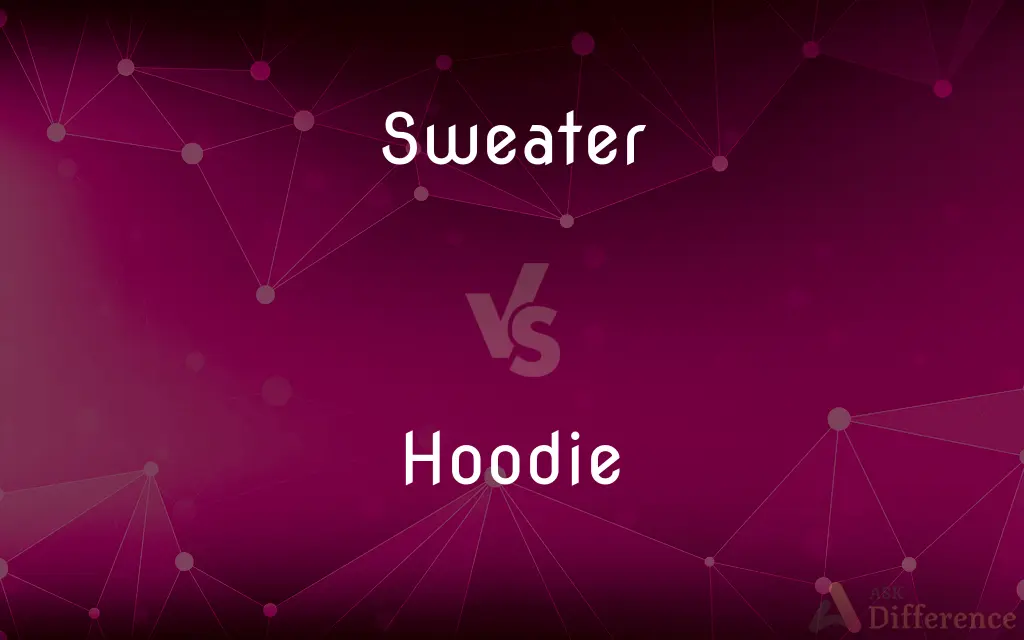Sweater vs. Hoodie — What's the Difference?
By Tayyaba Rehman — Updated on October 9, 2023
Sweater is knitted garment typically with long sleeves. Hoodie is hooded sweatshirt or jacket, often with a front pocket. Sweaters often prioritize warmth and are knit, while hoodies, typically casual, feature a hood and are made from sweatshirt material.

Difference Between Sweater and Hoodie
Table of Contents
ADVERTISEMENT
Key Differences
A sweater predominantly underscores warmth, traditionally being knitted or crocheted and designed to encapsulate heat. Typically presenting in various styles, such as pullovers and cardigans, sweaters tend to exude a spectrum of casual to semi-formal aesthetics, becoming a staple in diverse wardrobes. Contrastingly, a hoodie hinges largely on a casual and athletic visual language, intrinsically integrating a hood and occasionally a frontal pouch, making it both practical and an unspoken symbol of relaxed, easygoing attire.
Exploring materials, sweaters are often crafted from a myriad of fibers, including wool, cotton, and synthetic alternatives, usually employing knitting techniques that inherently cater to heat retention and comfort. The hoodie, while also available in various materials, is frequently constituted of sweatshirt fabric, a typically cotton-polyester blend which provides a cozy, soft inside surface and a smooth outer layer, aligning with its athletic and leisure-centric image.
When traversing through social and cultural landscapes, the sweater often holds a more universal appeal, effortlessly weaving through varied social scenarios and being accepted in semi-formal settings, especially when crafted from luxurious materials or featuring intricate patterns. Conversely, the hoodie, often drenched in youthful and subcultural connotations, can be seen as a rebellious or laid-back garment, sometimes acting as a canvas for graphic prints, brand logos, and expressive art.
Moreover, sweaters commonly adapt to various seasonal fashion trends, embracing diverse styles, patterns, and fits, such as oversized, fitted, or cropped versions, echoing the prevailing sartorial sentiment. In an analogous manner, the hoodie also partakes in stylistic explorations, albeit within its inherently casual framework, assimilating influences from streetwear, sportswear, and contemporary fashion while steadfastly retaining its characteristic hood and relaxed demeanor.
In a practicable context, sweaters often elevate an ensemble, effortlessly balancing comfort with a dash of formality or sophisticated casualness, suitable for dinners, workplaces, or seasonal gatherings. Hoodies, encapsulating a more relaxed and utilitarian essence, lend themselves seamlessly to athletic pursuits, casual outings, or expressive streetwear looks, offering both comfort and a straightforward style statement.
ADVERTISEMENT
Comparison Chart
Typical Material
Knitted (wool, cotton, synthetic)
Sweatshirt fabric (cotton blend)
Key Feature
Often lacks a hood
Always has a hood
Formality Level
Can be casual to semi-formal
Generally casual
Style Variations
Pullovers, cardigans, etc.
Typically one style with variations
Cultural Connotation
Universal, timeless
Youthful, casual, subcultural
Compare with Definitions
Sweater
A sweater is a knitted garment for upper body.
Her sweater was adorned with intricate patterns.
Hoodie
Hoodies often feature a frontal pouch or pocket.
She tucked her hands into the hoodie's front pocket.
Sweater
Sweaters are crafted for warmth and comfort.
He donned a sweater to combat the chilly evening.
Hoodie
A hoodie commonly signifies casual wear.
The printed hoodie was ideal for the laid-back weekend.
Sweater
A sweater can be made from various fibers.
The wool sweater was remarkably soft and cozy.
Hoodie
A hoodie is a hooded sweatshirt or jacket.
He wore a hoodie during the early morning jog.
Sweater
A sweater might exhibit intricate patterns or solids.
The argyle sweater was a hit at the holiday party.
Hoodie
Hoodies often become canvases for graphic prints.
His hoodie showcased vibrant street art.
Sweater
Sweaters often present in diverse styles.
The V-neck sweater complimented his shirt underneath.
Hoodie
A hoodie might be zippered or pullover style.
She preferred zippered hoodies for convenience.
Sweater
A sweater or pullover, also called a jumper in British and Australian English, and a windcheater in parts of Australia, is a piece of clothing, typically with long sleeves, made of knitted or crocheted material, that covers the upper part of the body. When sleeveless, the garment is often called a slipover or sweater vest.
Hoodie
A hoodie (in some cases it is also spelt hoody and alternatively known as a hooded sweatshirt) is a sweatshirt with a hood. Hoodies often include a muff sewn onto the lower front, and (usually) a drawstring to adjust the hood opening.
Sweater
A garment for the upper body of wool, cotton, or synthetic yarn, typically knitted, having long sleeves, and worn in cold weather.
Hoodie
A hooded garment, especially a hooded sweatshirt.
Sweater
One that sweats, especially profusely.
Hoodie
A sweatshirt with an integral hood and, sometimes, a large kangaroo pocket at the front.
You can buy hoodies on the cheap in summer.
Sweater
Something that induces sweating; a sudorific.
Hoodie
A young person wearing such a sweatshirt, usually a male, stereotypically associated with antisocial behaviour.
Sweater
A knitted jacket or jersey, usually of thick wool, worn by athletes before or after exercise.
Hoodie
(slang) foreskin
Sweater
(US) A similar garment worn for warmth.
Hoodie
The hooded crow, Corvus cornix.
Sweater
One who sweats (produces sweat).
Sweater
One who or that which causes to sweat.
Sweater
A diaphoretic remedy.
Sweater
(historical) An exploitative middleman who subcontracted piece work in the tailoring trade.
Sweater
(archaic) One who sweats coins, i.e. removes small portions by shaking them.
Sweater
A London street ruffian in Queen Anne's time who prodded weak passengers with his sword-point.
Sweater
(transitive) To dress in a sweater.
Sweater
One who sweats.
Sweater
One who, or that which, causes to sweat
Sweater
A crocheted or knitted garment covering the upper part of the body
Sweater
A person who perspires
Common Curiosities
Can sweaters be formal?
Sweaters can range from casual to semi-formal based on style and material.
What is a hallmark feature of a sweater?
A sweater is typically a knitted garment designed for warmth.
Are hoodies considered athletic wear?
Yes, hoodies are often associated with casual and athletic wear.
What are common materials for sweaters?
Sweaters may be made from wool, cotton, synthetic fibers, or blends.
Do hoodies always have a pocket?
While common, not all hoodies have a frontal pouch or pocket.
Can a sweater be worn for dressy occasions?
Yes, certain sweaters can be suitable for dressier occasions.
Are all sweaters knit?
While many are, sweaters can also be crocheted or made from woven fabric.
What defines a hoodie?
A hoodie is a casual, often loose-fitting sweatshirt with a hood.
Are hoodies and sweatshirts the same?
They’re similar, but a hoodie specifically has a hood, while a sweatshirt may not.
Are hoodies associated with certain subcultures?
Yes, hoodies are prominent in subcultures like streetwear and skate culture.
Are hoodies suitable for summer?
Lightweight hoodies can be worn in summer, especially in cooler evenings.
Are sweaters and jumpers synonymous?
In American English, they are, but in British English, they often refer to similar, yet distinct garments.
Can a hoodie be worn under a jacket?
Yes, hoodies are often layered under jackets for extra warmth or style.
Can sweaters accommodate various neck styles?
Absolutely, sweaters can feature V-necks, crew necks, turtlenecks, etc.
Do sweaters only come in solid colors?
No, sweaters can feature solid colors, patterns, prints, or embellishments.
Share Your Discovery

Previous Comparison
Colloquialism vs. Metaphor
Next Comparison
Synonym vs. ThesaurusAuthor Spotlight
Written by
Tayyaba RehmanTayyaba Rehman is a distinguished writer, currently serving as a primary contributor to askdifference.com. As a researcher in semantics and etymology, Tayyaba's passion for the complexity of languages and their distinctions has found a perfect home on the platform. Tayyaba delves into the intricacies of language, distinguishing between commonly confused words and phrases, thereby providing clarity for readers worldwide.















































